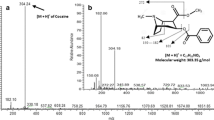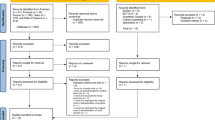Abstract
Crack-cocaine is a cocaine by-product widely consumed by general population in developing countries. The drug is low cost and is associated with more intense effects when compared to other illicit drugs. Genotoxicity, oxidative stress, and inflammatory response are considered crucial events in carcinogenesis, since they actively participate in the multistep process. The purpose of this paper was to provide a mini review regarding the relationship between carcinogenesis and genotoxicity, oxidative stress, and inflammation induced by crack-cocaine. The present study was conducted on search of the scientific literature from the published studies available in PubMed, MEDLINE, Scopus, and Google Scholar for all kind of articles (all publications to November 2020) using the following key words: crack-cocaine, DNA damage, genotoxicity, cellular death, cytotoxicity, mutation, oxidative stress, inflammation, and mutagenicity. The results showed that published papers available were almost all in vivo test system being conducted in humans or rodents. Crack-cocaine was able to induce genotoxicity and oxidative stress in mammalian cells. However, the role of inflammatory response after exposure to crack-cocaine was not conclusive so far. In summary, this study is consistent with the notion that crack-cocaine is a chemical carcinogen as a result of genotoxicity and oxidative stress induced in mammalian and non-mammalian cells.


Similar content being viewed by others
Data availability
Data sharing is not applicable to this article as no datasets were generated or analysed during the current study.
References
Abreu ÂMM, Jomar RT, Taets GGC, Souza MHDN, Fernandes DB (2018) Screening and brief intervention for the use of alcohol and other drugs. Rev Bras Enferm 71(suppl 5):2258–2263
Albini MB, Malacarne IT, Batista TBD, de Lima AAS, Machado MAN, Johann ACBR, Rosa EAR, Azevedo-Alanis LR (2017) Cytopathological changes induced by the crack use in oral mucosa. Eur Addict Res 23(2):77–86
Almeida TC, Stefanon EB, Rech VC, Sagrillo MR, Bohrer PL (2012) Analysis of oral mucosa of users of crack through micronucleus technique. Clin Lab 58(11-12):1269–1275
Angelieri F, Yujra VQ, Oshima CTF, Ribeiro DA (2017) do dental x-rays induce genotoxicity and cytotoxicity in oral mucosa cells? A critical review. Anticancer Res 37(10):5383–5388
Antoniazzi RP, Zanatta FB, Rösing CK, Feldens CA (2016) Association among periodontitis and the use of crack-cocaine and other illicit drugs. J Periodontol 87(12):1396–1405
Antoniazzi RP, Lago FB, Jardim LC, Sagrillo MR, Ferrazzo KL, Feldens CA (2018) Impact of crack-cocaine use on the occurrence of oral lesions and micronuclei. Int J Oral Maxillofac Surg 47(7):888–895
Baik J (2013) Dopamine signaling in reward-related behaviors. Front Neural Circuit 7:152
Coelho MPP, Diniz KGD, Bering T, Ferreira LDSA, Vieira DA, Castro MRC, Correia MITD, Rocha GA, Teixeira R, Garcia FD, Silva LD (2020) Skeletal muscle mass index and phase angle are decreased in individuals with dependence on alcohol and other substances. Nutrition 71:110614
Cury PR, Oliveira MG, Dos Santos JN (2017) Periodontal status in crack and cocaine addicted men: a cross-sectional study. Environ Sci Pollut Res Int 24(4):3423–3429
Cury PR, Araujo NS, das Graças Alonso Oliveira M, Dos Santos JN (2018) Association between oral mucosal lesions and crack and cocaine addiction in men: a cross-sectional study. Environ Sci Pollut Res Int 25(20):19801–19807
Dackis CA, O’Brien CP (2001) Cocaine dependence: a disease of the brain’s reward centers. J Subst Abuse Treat 21(3):111–117
das Graças Alonso de Oliveira M, Dos Santos JN, Cury PR, da Silva VH, Oliveira NR, da Costa Padovani R, Tucci AM, Ribeiro DA (2014) Cytogenetic biomonitoring of oral mucosa cells of crack-cocaine users. Environ Sci Pollut Res Int 21(8):5760–5764
de Freitas TA, Palazzo RP, de Andrade FM, Reichert CL, Pechansky F, Kessler F, de Farias CB, de Andrade GG, Leistner-Segal S, Maluf SW (2014) Genomic instability in human lymphocytes from male users of crack-cocaine. Int J Environ Res Public Health 11(10):10003–10015
Dos Santos Barbosa Ortega A, Maranho LA, Nobre CR, Moreno BB, Guimarães RS, Lebre DT, de Souza Abessa DM, Ribeiro DA, Pereira CDS (2019) Detoxification, oxidative stress, and genotoxicity of crack-cocaine in the brown mussel Perna perna. Environ Sci Pollut Res Int 26(27):27569–27578
Florence AT, Attwood D (2006) Physicochemical principles of pharmacy, 6th edn. Pharmaceutical Press, London, pp 148–154
Garcia RC, Dati LM, Fukuda S, Torres LH, Moura S, de Carvalho ND, Carrettiero DC, Camarini R, Levada-Pires AC, Yonamine M, Negrini-Neto O, Abdalla FM, Sandoval MR, Afeche SC, Marcourakis T (2012) Neurotoxicity of anhydroecgonine methyl ester, a crack-cocaine pyrolysis product. Toxicol Sci 128(1):223–234
Garcia RC, Dati LM, Torres LH, da Silva MA, Udo MS, Abdalla FM, da Costa JL, Gorjão R, Afeche SC, Yonamine M, Niswender CM, Conn PJ, Camarini R, Sandoval MR, Marcourakis T (2015) M1 and M3 muscarinic receptors may play a role in the neurotoxicity of anhydroecgonine methyl ester, a cocaine pyrolysis product. Sci Rep 5:17555
Garcia RCT, Torres LL, Dati LMM, Loureiro APM, Afeche SC, Sandoval MRL, Marcourakis T (2019) Anhydroecgonine methyl ester (AEME), a cocaine pyrolysis product, impairs glutathione-related enzymes response and increases lipid peroxidation in the hippocampal cell culture. Toxicol Rep 6:1223–1229
Gicquelais RE, Jannausch M, Bohnert ASB, Thomas L, Sen S, Fernandez AC (2020) Links between suicidal intent, polysubstance use, and medical treatment after non-fatal opioid overdose. Drug Alcohol Depend In press 212:108041
Gomes EF, Lipaus IFS, Martins CW, Araújo AM, Mendonça JB, Pelição FS, Lebarch EC, de Melo Rodrigues LC, Nakamura-Palacios EM (2018) Anhydroecgonine methyl ester (AEME), a product of cocaine pyrolysis, impairs spatial working memory and induces striatal oxidative stress in rats. Neurotox Res 34(4):834–847
Hanahan D, Weinberg RA (2011) Hallmarks of cancer: the next generation. Cell 144(5):646–674
Hannan MA, Dash R, Haque MN, Mohibbullah M, Sohag AAM, Rahman MA, Uddin MJ, Alam M, Moon IS (2020) neuroprotective potentials of marine algae and their bioactive metabolites: pharmacological insights and therapeutic advances. Mar Drugs 18(7):347
Klaunig JE, Xu Y, Isenberg JS, Bachowski S, Kolaja KL, Jiang J, Stevenson DE, Walborg EF Jr (1998) The role of oxidative stress in chemical carcinogenesis. Environ Health Perspect 106(Suppl 1):289–295
Knerich V, Jones AA, Seyedin S, Siu C, Dinh L, Mostafavi S, Barr AM, Panenka WJ, Thornton AE, Honer WG (2019) Rutherford AR (2019) Social and structural factors associated with substance use within the support network of adults living in precarious housing in a socially marginalized neighborhood of Vancouver, Canada. PLoS One 14(9):e0222611
Korniluk A, Koper O, Kemona H, Dymicka-Piekarska V (2017) From inflammation to cancer. Ir J Med Sci 186(1):57–62
Levandowski ML, Hess AR, Grassi-Oliveira R, de Almeida RM (2016) Plasma interleukin-6 and executive function in crack-cocaine-dependent women. Neurosci Lett 628:85–90
Lipaus IFS, Gomes EF, Martins CW, E Silva CM, RGW P, Malgarin F, Schuck PF, Palacios EMN, de Melo Rodrigues LC (2019) Impairment of spatial working memory and oxidative stress induced by repeated crack-cocaine inhalation in rats. Behav Brain Res 359:910–917
Maranho LA, Fontes MK, Kamimura ASS, Nobre CR, Moreno BB, Pusceddu FH, Cortez FS, Lebre DT, Marques JR, Abessa DMS, Ribeiro DA, Pereira CDS (2017) Exposure to crack-cocaine causes adverse effects on marine mussels Perna perna. Mar Pollut Bull 123(1-2):410–414
Moretti EG, Yujra VQ, Claudio SR, Silva MJ, Vilegas W, Pereira CD, de Oliveira F, Ribeiro DA (2016) Acute crack-cocaine exposure induces genetic damage in multiple organs of rats. Environ Sci Pollut Res Int 23(8):8104–8112
Morton W (1999) Cocaine and psychiatric symptoms. Prim care companion. J Clin Psychiatr 1:109–113
Narvaez JC, Magalhães PV, Fries GR, Colpo GD, Czepielewski LS, Vianna P, Chies JA, Rosa AR, Von Diemen L, Vieta E, Pechansky F, Kapczinski F (2013) Peripheral toxicity in crack-cocaine use disorders. Neurosci Lett 544:80–84
Noda N, Wakasugi H (2001) Cancer and oxidative stress. Japan Med Assoc J 44(12):535–539
Parcianello RR, Mardini V, Ceresér KMM, Langleben DD, Xavier F, Zavaschi MLS, Rhode LAP, Pechansky F, Gubert C, Szobot CM (2018) Increased cocaine and amphetamine-regulated transcript cord blood levels in the newborns exposed to crack-cocaine in utero. Psychopharmacology 235(1):215–222
Reuter S, Gupta SC, Chaturvedi MM, Aggarwal BB (2010) Oxidative stress, inflammation, and cancer: how are they linked? Free Radic Biol Med 49(11):1603–1616
Ribeiro M, Dunn J, Sesso R, Dias AC, Laranjeira R (2006) Causes of death among crack-cocaine users. Braz J Psychiatry 28(3):196–202
Rosário BDA, de Nazaré MFS, Estadella D, Ribeiro DA, Viana MB (2019) Behavioral and neurobiological alterations induced by chronic use of crack-cocaine. Rev Neurosci 31(1):59–75
Sordi AO, Pechansky F, Kessler FH, Kapczinski F, Pfaffenseller B, Gubert C, de Aguiar BW, de Magalhães Narvaez JC, Ornell F, von Diemen L (2014) Oxidative stress and BDNF as possible markers for the severity of crack-cocaine use in early withdrawal. Psychopharmacology 231(20):4031–4039
Sordi AO, von Diemen L, Kessler FH, Schuch S, Ornell F, Kapczinski F, Pfaffenseller B, Gubert C, Wollenhaupt-Aguiar B, Salum GA, Pechansky F (2020) Effects of childhood trauma on BDNF and TBARS during crack-cocaine withdrawal. Braz J Psychiatry 42(2):214–217
Souza-Silva EM, Alves RB, Simon KA, Hueza IM (2020) Crack-cocaine smoke on pregnant rats: maternal evaluation and teratogenic effect. Hum Exp Toxicol 39(4):411–422
Stefanidou M, Alevisopoulos G, Maravelias C, Loutsidis C, Koutselinis A (1999) Phagocytosis of the protozoon Tetrahymena pyriformis as an endpoint in the estimation of cocaine salt and cocaine freebase toxicity. Addict Biol 4(4):449–452
Stefanidou M, Chatziioannou A, Livaditou A, Rellaki A, Alevisopoulos G, Spiliopoulou H, Koutselinis A (2002) DNA toxicity of cocaine hydrochloride and cocaine freebase by means of DNA image analysis on Tetrahymena pyriformis. Biol Pharm Bull 25(3):332–334
Stefanidou ME, Hatzi VI, Terzoudi GI, Loutsidou AC, Maravelias CP (2011) Effect of cocaine and crack on the ploidy status of Tetrahymena pyriformis: a study using DNA image analysis. Cytotechnology. 63(1):35–40
Uddin MS, Kabir MT (2019) Oxidative stress in Alzheimer’s Disease: molecular hallmarks of underlying vulnerability. In: Ashraf G, Alexiou A (eds) Biological, diagnostic and therapeutic advances in Alzheimer’s disease, 1st edn. Springer Nature, pp 91–115
Uddin MS, Kabir MT, Mamun AA, Barreto GE, Rashid M, Perveen A, Ashraf GM (2020a) Pharmacological approaches to mitigate neuroinflammation in Alzheimer’s disease. Int Immunopharmacol 84:106479
Uddin MS, Hasana S, Ahmad J, Hossain MF, Rahman MM, Behl T, Rauf A, Ahmad A, Hafeez A, Perveen A, Md Ashraf G (2020b) Anti-neuroinflammatory potential of polyphenols by inhibiting NF-kappaB to halt Alzheimer’s disease. Curr Pharm Des. https://doi.org/10.2174/1381612826666201118092422
UNODC (2019) Available from: https://www.unodc.org/lpo-brazil/pt/frontpage/2014/06/26-world-drug-report-2014.html. Assessed July, 24, 2019.
Webber LP, Pellicioli AC, Magnusson AS, Danilevicz CK, Bueno CC, Sant’Ana Filho M, Rados PV, Carrard VC (2016) Nuclear changes in oral mucosa of alcoholics and crack-cocaine users. Hum Exp Toxicol 35(2):184–913
Yujra VQ, Moretti EG, Claudio SR, Silva MJ, Oliveira F, Oshima CT, Ribeiro DA (2016) Genotoxicity and mutagenicity induced by acute crack-cocaine exposure in mice. Drug Chem Toxicol 39(4):388–391
Zaparte A, Viola TW, Grassi-Oliveira R, da Silva Morrone M, Moreira JC, Bauer ME (2015) Early abstinence of crack-cocaine is effective to attenuate oxidative stress and to improve antioxidant defences. Psychopharmacology 232(8):1405–1413
Funding
DVS and BAR are recipients from CAPES (Coordenação de Apoio de Pessoal de Nivel Superior, master level, Grant number #001). MBV, CDSP, JNS, and DAR are recipients from CNPq (Conselho Nacional de Desenvolvimento Cientifico e Tecnologico, grant number #001).
Author information
Authors and Affiliations
Contributions
ITM, DVS, DAR, and BAR made the literature search. MBV, CDSP, DE, and DAR performed data interpretation. All authors wrote the manuscript.
Corresponding author
Ethics declarations
Conflict of interest
All authors declare no conflict of interest.
Additional information
Responsible Editor: Mohamed M. Abdel-Daim
Publisher’s note
Springer Nature remains neutral with regard to jurisdictional claims in published maps and institutional affiliations.
Rights and permissions
About this article
Cite this article
Malacarne, I.T., De Souza, D.V., Rosario, B.D.A. et al. Genotoxicity, oxidative stress, and inflammatory response induced by crack-cocaine: relevance to carcinogenesis. Environ Sci Pollut Res 28, 14285–14292 (2021). https://doi.org/10.1007/s11356-021-12617-2
Received:
Accepted:
Published:
Issue Date:
DOI: https://doi.org/10.1007/s11356-021-12617-2




